|
|
St Albans Historical & Picturesque Charles H Ashdown Illus: Frederic G Kitton Elliot Stock, London, 1893 |
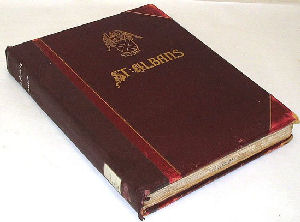 |
|||
The following extracts are from a very long review from The Antiquary Volume 29, Jan-Jun 1894 [full review available online] St. Albans : Historical and Picturesque, with an Account of the Roman City of Verulam. By Charles H. Ashdown. Illustrated by Frederic G. Kitton. Elliot Stock. 4to., pp. xii, 308, seventeen plates, and ninety-four text illustrations. Price £2 2s. ST. ALBANS is an English town so brimful of interest and so justly entitled to distinction, that it is not a little remarkable that no monograph the least bit worthy of the place has hitherto been attempted. To Messrs. Ashdown and Kitton belongs the distinction of not only making the attempt, but of achieving a considerable measure of success. They do not, however, lay claim to any exhaustive search of records, and several of our towns have fallen into the hands of more erudite topographers ; but they are to be much congratulated on these pleasantly written, and in the main accurately compiled, pages, and more especially on the many charming drawings, which, alas ! but too often represent bits that have quite recently disappeared or have been improved and restored till they have lost all trace of true beauty or value. [the review end] This beautiful work, which does much credit to all engaged in its production, is limited to three hundred copies. We should think it probable that all or nearly all will have been taken up before this notice appears.
The next two sections are occupied with a descriptive account of the general features and component parts of the Abbey of St. Albans, as well of its various relics and furniture that are now extant, or of which we possess some definite record. |
 |
||||
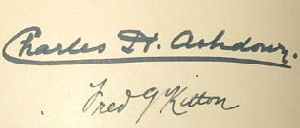 |
|||||
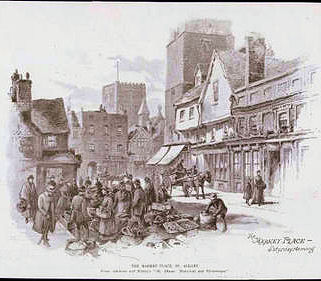 |
|||||
| Illustrations on this page from Live Auctions and the St Albans Museum web site, | |||||
ST. ALBANS is an English town so brimful of interest and so justly entitled to distinction, that it is not a little remarkable that no monograph the least bit worthy of the place has hitherto been attempted. To Messrs. Ashdown and Kitton belongs the distinction of not only making the attempt, but of achieving a considerable measure of success. They do not, however, lay claim to any exhaustive search of records, and several of our towns have fallen into the hands of more erudite topographers ; but they are to be much congratulated on these pleasantly written, and in the main accurately compiled, pages, and more especially on the many charming drawings, which, alas ! but too often represent bits that have quite recently disappeared or have been improved and restored till they have lost all trace of true beauty or value.
[the review end]
This beautiful work, which does much credit to all engaged in its production, is limited to three hundred copies. We should think it probable that all or nearly all will have been taken up before this notice appears.
|
[The following paragraphs relate to the post-medieval period which is most relevant to visitors to this web site. Note the way the reviewer criticised the restoration of the Abbey.] |
The next two sections are occupied with a descriptive account
of the general features and
component parts of the Abbey of St. Albans,
as well of its various relics and furniture
that are now extant, or of which we possess
some definite record.
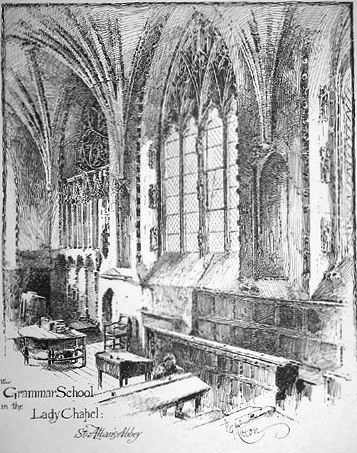 |
In the centre of the Ante-Chapel to the Lady
Chapel, otherwise termed the Chapel of St.
Amphibalus, stood until recently the pedestal
of the shrine of that saint, which was
erected by Ralph Witchurch, sacrist, during
the abbacy of Thomas de la Mare, 1349-96.
The foolish modern notions of gaining
"an uninterrupted view" as if a big
church had been constructed to serve the
purposes of an important Railway-station, through
which it is imperative that the signalmen
can see from end to end has caused
the removal of this basement, together with the upper part of the shrine discovered
in 1872, to the north aisle of the Saints'
Chapel. Whether it is to be allowed to
remain there we know not, so inexplicable are
the ways and changing freaks of the autocrat
of the abbey.
This shrine, which is in a much more imperfect
condition than that of St. Alban, must originally have been a work of much beauty.
It still bears the initials of the donor,
"R. W.," on the north and south faces.
The east front "was originally adorned
with images and plates of gold and silver,
while upon the summit rested the portable
shrine or feretrum." A small altar stood
at the west end of the shrine, at the foot
of which William, Bishop of Chester, formerly
Abbot of St. Albans, was buried in 1447.
Certain portions of the shrine of St. Alban were
found in 1847, but when some material that
blocked up a doorway and screen of the south
aisle of the presbytery was being removed
in 1872, an immense number of fragments
of Purbeck marble were brought to
light, from which the ancient early fourteenth-century shrine, most richly
carved, has been to a great
extent reconstructed. We are able
to give Mr. Kitten's drawing of the
most interesting fragment of this once noble
achievement in stone.
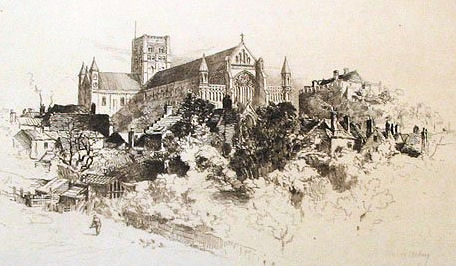 |
The account of the unhappy " restoration " of
the abbey church, which has been in progress
from 1870 up to the present day, and
the controversies the process has excited, are
given in a brief form and with a most lenient
and qualified judgment. This can scarcely
be otherwise in a book not intended to
be critical, but merely to satisfy the desire to
have an artistic and fairly accurate memorial
of an ancient city ; but never throughout
Christendom has such irreparable mischief
been done under the shelter of that terribly
misused word "restoration." Mr. Ashdown
shall tell the tale of the disastrous abandonment
of the famed abbey church to the
caprices of a man of undoubted ability, but
of headstrong and defiant will, and, unhappily, bereft of any spark of
historic sympathy :
"In 1877," says Mr. Ashdown, "a faculty was
granted to repair and restore, the church, and
fit it for cathedral and parochial services ; but
the committee soon afterwards found themselves
£3,000 in debt, and it was at this
critical juncture that a new faculty was granted
to Lord Grimthorpe (then Sir Edmund Beckett), by which he acquired unlimited
powers to restore, repair, and refit the
abbey at his own expense. There was no
alternative open to the committee but to accept
what must under the circumstances be
considered as an extremely generous offer, notwithstanding
the stringent and unalterable conditions
imposed by the benefactor. For thirteen
or fourteen years his lordship has sedulously
carried out the requisite work, expending
annually a sum estimated at £10,000.
His method of procedure, however, evoked considerable adverse criticism
from those interested in the abbey, who protested
vigorously against the ruthless effacement
of many notable features that were
inseparably connected with the past history
of the ancient building. The new west
front and the windows inserted in the terminations
of the transepts appear to be the
chief points for divergence of opinion, and
those of a thoughtful and artistic temperament have reason to regret that
absence of sympathetic treatment
with respect to the more
interesting architectural features, the antiquity
and integrity of which Sir Gilbert Scott
endeavoured most conscientiously to retain.
But whatever may be the merits or demerits
of the method pursued by Lord Grimthorpe,
the incontrovertible fact remains that
to him St. Albans owes the preservation of
her famous abbey church, which would undoubtedly
have fallen into hopeless ruin but
for his timely and princely munificence."
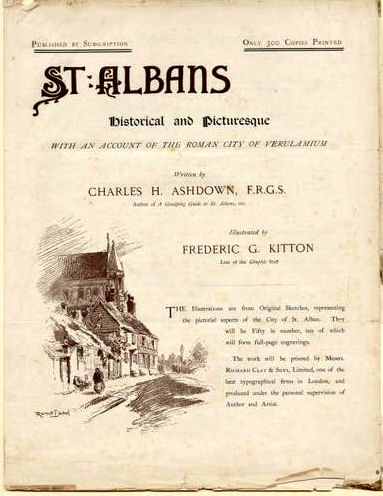 |
|
|
Subscription Leaflet |
To the last sentence of this paragraph we object
in toto. St. Albans does not owe the preservation
of her famous abbey church to Lord
Grimthorpe. Contrariwise he has been doing
his best to obliterate it, and to give England
in its place his own crude concaptions of what it ought to be. Had Lord Grimthorpe
given, say, £20,000, to be expended on the careful preservation from decay
of this great historic church, and spent
another $20,000 on its reverent fitting-up for stately worship, he would,
indeed, have been a benefactor ;
but the squandering of £140,000,
which his friends claim that he has
laid out on the fabric, is a miserable misuse
of his inherited or self-earned wealth. No
personal sin, save that of the most over-weening egotism, has been involved
in this expenditure ; but apart
from moral grounds, and in the
interests of the history in stone of England's
past both in Church and State, it would
have been far better had Lord Grimthorpe squandered this misused sum on the racecourse,
or flung it away on the gaming tables
of Monte Carlo.
We have almost exhausted the space at our
bestowal, but one or two more paragraphs must
be allowed to draw attention to the larger
half of this fascinating volume, which yet
remains for consideration. Chapter VIII
is occupied with the story of the
Peasant Revolt and an account of the great gateway
of the monastery. To this follow birth
notices of the famous English historians connected
with St. Albans Roger de Wendover, Matthew
Paris, Rishanger, and Walsingham and a well-written account of the Grammar
School, its masters and famous scholars.
The little that is known of the Saxon
fortress-palace of Kingsbury and of the
Priory of Sopwell are next put on record.
A short chapter is appropriately given to the
parish church of St. Stephen, which was one
of the three churches originally built by Abbot
Ulsinus about the year 948. It was rebuilt
temp. Henry I., and again much restored
in the fifteenth century. In 1861 it
fell into the hands of Sir Gilbert Scott, which
was one of his worst periods. The most
noteworthy feature of the church is the old
brass lectern of massive workmanship. It
bears the black-letter inscription : Georgius Creichtown
Episcopus Dunkeldensis. There were
two Scotch Bishops of Dunkeld of that name
; the first was consecrated in 1527, and the
second (the nephew of the first) was consecrated in 1550 and was the last
bishop of that see. It must have
belonged to the first of these
prelates. The most likely supposition to account for its presence in this church
is that this eagle-lectern formed part of
the plunder of the abbey church of Holyrood, and was brought here by Sir
Richard Lee. The church of St.
Gregory, Norwich, possesses a
brass lectern almost identical with
the one at St. Stephen's.
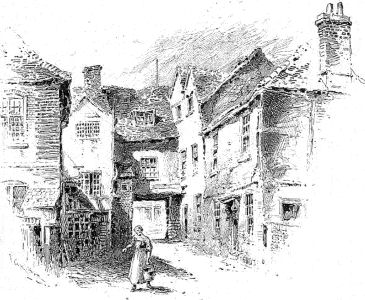 |
|
|
The White Hart Yard |
Chapter XIV. is devoted to interesting gossip
and reminiscences of Holywell Hill, the
ancient cross, the numerous old inns, and
the coaching days of yore. The High Street
and St. Peter's Street and its by-ways are
treated in a similar and well-illustrated manner
in the next two chapters.
The Market Place, French Row, and the Moot
Hall are the chief objects treated of in the
seventeenth chapter. Some of the old bits
that still happily remain lend themselves readily
to the pencil of the appreciative draughtsman.
Mr. Kitton gives several delightful sketches of these old details. " The
Clock Tower and Curfew Bell,"
"George Street and Romeland,"
"St. Michael's and its
Neighbourhood," and "The Tokens of St.
Albans," are the titles of the last chapters.
|
CONTENTS |
||
| Introduction | ||
| List of Illustrations | ||
| I | Verulamium | |
| II | Verulamium (continued) | |
| III | Monastic Records of St Albans and Lives of the Abbots | |
| IV | Lives of the Abbots (continued) | |
| V | The Battle of St Albans: and Later Abbots | |
| VI | St Albans Abbey | |
| VII | St Albans Abbey (continued) | |
| VIII | The Peasant Revolt, and the Great Gateway of the Monastery | |
| IX | St Albans and its Famous Historians | |
| X | The Grammar School | |
| XI | The Saxon Fortress-Palace of Kingsbury | |
| XII | Sopwell Ruins | |
| XIII | St Stephen's Church | |
| XIV | Holywell Hill and its Associations | |
| XV | The High Street | |
| XVI | St Peter's Street and its Byways | |
| XVII | The Market Place and French Row | |
| XVIII | The Clock Tower and the Curfew Bell | |
| XIX | George Street and Romeland | |
| XX | ST Michael and its Neighbourhood | |
| The Tokens of St Albans | ||
| Appendix | ||
| Index | ||
| List of Abbots | ||
| Authorities Quoted | ||
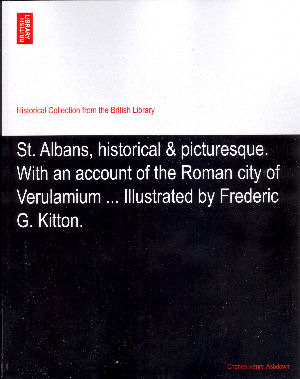
The book has been digitised by the British Library and is available in book form. The many images are fainter than the original but are of an adequate quality, as shown by the following detail of an in-text engraving of a market stall at the foot of the clock tower.
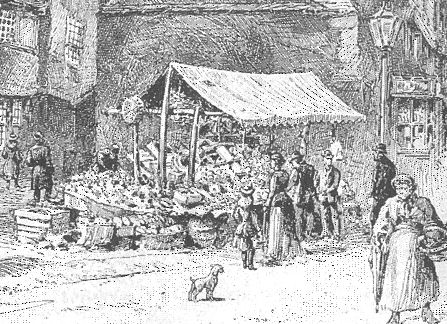
| Locating
Books At the time this page was last updated second hand copies were available online. New copies of the 2008 reprint are widely available online. |
| July 2010 | Page Created | |
| August 2010 | Contents list and details of reprint |

